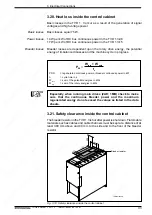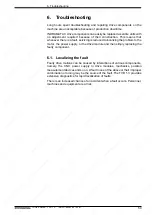
38
• DOK-POWER*-TVD*1.3****-ANW1-EN-E1,44 • 02.97
4. TVD 1.3 Interconnections
4.3. TVD interconnect with E-stop relay with DC bus
dynamic braking
Excellent safety at low cost is achieved with this variant. The monitoring
devices built into the drive system are used most effectively.
• in larger plants where monitoring or numerous E-stop switches are required,
• if the TVD is supplying feed drives only and
• if synchronous and inductance drives are operted from the same TVD.
The NCB link on the TVD (X3/1 - X3/2) may not be jumpered.
DC bus dynamic braking always brakes synchronous motors to a controlled
standstill regardless of whether the drive electronics are still functioning or not.
DC bus is short-circuited only if there is a fault in the drives. If the E-stop relay
is switched off, then inductance main drives can be braked as well.
If there is an E-stop or one of the monitor circuits of the TVD is tripped, for
example, with a power failure, the drives are braked at maximum torque under
drive regulation.
Features
Application
Source of danger:
The DC bus dynamic brake protects machines in the event of drive
failure. It alone does not function to protect personnel. In the event of
faults in the drive and the supply module, uncontrolled drive
movements are still possible even if the DC bus dynamic brake (X2/
2 = 0) is activated.
Possible cauess:
Injury to personnel is possible depending upon the type of machine.
How to avoid:
Additional monitoring and safety devices can be installed on the
machine side.
When the E-stop button is pressed, the main contactor in the TVD drops out
immediately. The enable signal of the drives is dropped by means of an
auxiliary contact of the main contactor. This leads to a drive-internal switching
of the velocity command to zero in all drives in the drive packet. All drives are
braked under control.
A drive fault signal to the TVD 1.3 (Bb1 contact), a fault signal from the NC
(servo fault), or an overtravel signal from the overtravel limit switch cause the
main contactor to be switched off and the DC bus dynamic brake to be applied.
DC bus
dyn. brake
OFF
K1
(X5/3-4)
DC bus
voltage
UD contact
Drive enable from
control unit
t
1
≥
200 ms; t
2
= 1.25 ... 1.4 s; t
3
≥
40 ms
t
3
t
2
t
2
t
1
SVTVDmNA
Fig. 4.4: Signal path when powering up a TVD
Warning!
Mode of operation
















































